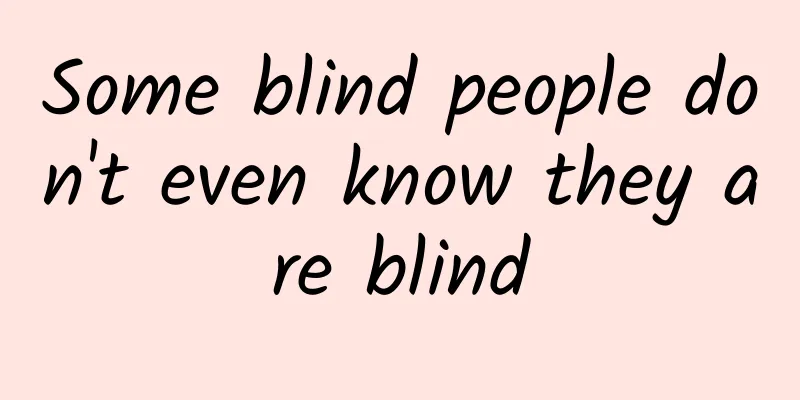Some blind people don't even know they are blind

|
The medical drama series "House MD" describes a police officer who became blind after being injured. The police officer did not feel that he was blind. When the doctor asked him what the other doctor was wearing, he answered without hesitation: "Dark blue pants, white shirt, black shoes." As if he really saw it. However, the doctor in front of him was dressed completely differently. No matter how the doctor explained, the police officer was still convinced that he could see and felt that he was fine. The doctor said that physically his eyes could see, but the problem was that his brain could not process the information normally. The plot is fictional, but similar phenomena do exist in the real world. When blind people do not consider themselves blind, their symptoms may be attributed to Anton's Syndrome. Disconnection between brain regions As early as the 1st century AD, the ancient Roman philosopher Lucius Annaeus Seneca mentioned a case in which a slave suffered acute blindness, but after that she did not admit that she was sick, always complaining that "the room was too dark" and constantly asking to change dormitories. Today we know that this is probably a kind of anosognosia, and patients may have cognitive impairment due to brain damage. However, the ancients more than 2,000 years ago probably could not look at this problem very scientifically and systematically. It was not until the end of the 19th century that an Austrian psychiatrist named Gabriel Anton encountered a special patient. Ursula Mercz, 56, was a former tailor who often suffered from dizziness and headaches. Later, people around her found that she was mentally abnormal, and her mental state also affected her work. Before Dr. Anton saw her, Ursula had been unable to work for two years. During Ursula's treatment, Dr. Anton discovered that she sometimes saw with a very narrow field of vision, and on the same day, this limited field of vision could turn into a complete blackness. As the disease progressed, the patient soon became completely blind (although the pupil reaction and fundus examination remained normal). At this time, she could no longer detect light and dark, could not perceive objects near or far, and even if someone suddenly moved towards her, Ursula's eyelids did not move. What puzzled the doctor was that during the whole process, the patient seemed to be unaware that she was losing or had already lost her vision - Ursula never complained about not being able to see, nor did she express how her life was affected by it. When the doctor put some objects in front of her eyes and asked Ursula what they were, she would calmly say that she saw them, but the objects she described were always different from the reality. Sometimes the doctor didn't put anything in front of her, but she still said she saw them. When asked how she felt about her vision, Ursula would give a general answer: It's just like that, it was better when I was young. Image source: pixabay If it is said that the patient does not know that he is blind because of intellectual impairment or confusion, it does not make sense in Ursula's case. After all, she also complains about other troubles, such as trying to say the name of something but often saying it wrong or not being able to remember it, and Ursula will express this trouble. In other words, she feels her language impairment, but she does not know that she has a visual impairment. Eventually, Ursula's condition worsened and she died in a long coma. Dr. Anton finished his work as the patient's attending physician, but his mission as a neuroscientist was not over yet. He dissected Ursula's brain to find out which area was wrong, causing the patient to not feel the loss of vision. Overall, the patient's brain did not shrink severely. However, in the cerebral cortex, the occipital lobe, which is mainly responsible for processing visual signals, has lesions in the subcortical white matter, causing a large amount of white matter loss. The occipital lobes on both sides have similar conditions, some occipital gyri have been damaged, and even the angular gyrus located at the junction of the occipital lobe and the parietal lobe has been injured. In the eyes of Dr. Anton, the symmetrical lesions in the occipital lobe are related to Ursula's blindness. She can't see because her eyes are not damaged, but the brain's ability to process visual signals is damaged. Perhaps you have noticed that it takes more than just your eyes to see the flowers and plants in the world. As a light sensor, the eyes are only responsible for collecting light, which is converted into neuronal signals and then processed by specific brain areas before it becomes the scenery we can appreciate. If the sensor is intact but the brain area that processes the signal fails, people will not have normal vision, which is also called "brain visual damage." It is not uncommon for humans to become blind due to brain damage, but this does not explain why Ursula thought she could see. Scientists are more concerned about whether the visual area in Ursula's brain still maintains normal connections with other brain areas. So, Dr. Anton began to observe some pathways in the patient's brain. He found that many pathways connecting the occipital lobe to other lobes were cut off, the visual cortex was disconnected from the surrounding area, and the connection between the left and right occipital lobes was also cut off. If the visual area cannot work properly and other brain areas do not receive the message of "visual area failure", it may make sense that the patient has difficulty perceiving his blindness. However, scientists are still not sure which specific brain area is damaged by the disease. “Because I don’t wear glasses.” When Dr. Anton showed Ursula objects, she would reach out and touch those that were close to her, but she would just guess or “make up” answers for those that were far away. In any case, she did not consider herself blind. Scientists suspect that even if the visual cortex loses its connection with surrounding areas, it can still receive stimulation from other areas. For example, researchers have found under a microscope that there are enough pathways to transmit stimulation from the temporal lobe to the visual center. However, whether this stimulation will be regarded as real vision cannot be judged from Ursula's case. In addition to Ursula, Dr. Anton encountered other patients who were unaware of their own illnesses. For example, a 69-year-old milker was not aware that she had lost her hearing, and this case appeared in a paper published in 1899 along with Ursula. In the early 20th century, a French neuroscientist named Joseph Babinski gave this phenomenon a name, "anosognosia," in which patients have no awareness of a specific sensory or functional defect. Visual anosognosia, later known as Anton's Syndrome or Anton-Babinski Syndrome, is still rare today, and the most common cause is an ischemic stroke that damages the bilateral occipital lobes. Like Ursula, these blind patients are unable to correctly answer what is in front of their eyes. But when they are told that their answers are wrong, they often deny that they are blind by saying "the light is too dim" or "I am not wearing glasses". However, some patients may be luckier than Ursula. Since Anton syndrome usually occurs after a cerebrovascular accident, the treatment plan is also mainly to protect the safety of blood vessels, such as controlling blood pressure, blood sugar and blood lipid levels, etc., plus standard drug treatments such as aspirin or statins. Young patients are usually able to recover without obvious damage to cognitive function, language or memory. References: https://academic.oup.com/book/12735 https://eyewiki.aao.org/Anton_Syndrome https://www.ncbi.nlm.nih.gov/books/NBK560626/ https://owenlab.uwo.ca/pdf/1993-David-COGNITIVE%20NEUROPSYCHOLOGY-An-annotated-summary-and-translation.pdf |
<<: A year's plan begins in spring. Pay attention to these 7 points when doing spring exercises!
Recommend
Does having sex before menstruation have any effect?
During menstruation, women's body functions w...
What to do if your skin itches after childbirth
There are many skin problems. When solving skin p...
How big a breast nodule needs to be removed surgically
Under normal circumstances, if the breast nodule ...
What is nine-valent HPV
The nine-valent HPV vaccine is used to prevent ce...
What are the side effects of taking oral contraceptives?
Many unmarried women and women who do not plan to...
Why do I have stomach pain after IUD removal?
In order to reduce the chance of pregnancy, many ...
Why did I still get pregnant after taking birth control pills?
In daily life, female friends may have unprotecte...
Is mochi bread a whole grain? How to store mochi if you can’t finish it?
Coarse grains are relative to the refined grains ...
What should I do if the maximum dose of statins still cannot bring my cholesterol level up to the target?
A friend told Huazi that he had coronary heart di...
Is a "clicking" sound in the joint a problem?
Bone and joint When we sit for a long time or mai...
What are the exercises for pregnant women?
Becoming a mother is what every woman desires, so...
What causes back pain after menstruation?
Women have their menstrual period every month, an...
Does uterine cold and pelvic inflammatory disease affect pregnancy?
The most common harm of pelvic inflammatory disea...
I stopped taking progesterone for 4 days and the pregnancy stopped.
After becoming pregnant, women must pay attention...
Can I take a shower after a painless abortion?
If contraception fails, you may get pregnant unex...









